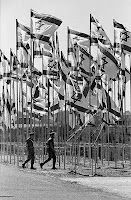 in a state institution. And there have been the usual disappointments that accompany any academic career, to say nothing of the special challenges faced by an eclectic humanist (who respects authors, intention, and value) in an academic discipline that prefers to read literature—all of human experience—through the prism of race, class, and gender.
in a state institution. And there have been the usual disappointments that accompany any academic career, to say nothing of the special challenges faced by an eclectic humanist (who respects authors, intention, and value) in an academic discipline that prefers to read literature—all of human experience—through the prism of race, class, and gender.But this evening I am thinking of the human relationships that will be lost. When a colleague who daily gave him the cut direct decided to leave Northwestern, Joseph Epstein said to me, “I shall miss not talking to him.” I too have had such colleagues, including those who will not even return a greeting when I am walking with students. Unlike Epstein, though, I never learned to enjoy the collegial chill, especially since there was no obvious reason for it besides political differences.
Although I will be escaping out from under the history of my relations with certain colleagues, I will also leave behind friends with whom I have shared many hours of intense discussion or relaxed conversation. There are a few men and women in the English department, most of whom are religious in one way or another, who seek out the expression of the past and practice what Pnin called “disinterested, devoted scholarship.” We sometimes felt ourselves under siege in College Station—a humanistic rump in an old technical college that has largely become a vocational school, where students know you by your grading standards, and pressed on the other side by the eager young colleague who is convinced that the novelties to which he subscribes will reign forever—our “bright replacement, present-minded,” in Nemerov’s words, who never
For the silly old scholar of the bad old days,
Who’d burn the papers and correct the leaves.
But what I will miss, far more than anything else, are the Aggies. They endure many jokes at their expense as if they were the Polacks of the academic world. Even Larry McMurtry, in Moving On, could not resist a crack about an Aggie and his tractor. Aggies are badly misunderstood, however. It is true they are not sophisticated, and it is true they are overwhelmingly Evangelical Christian and politically conservative, although the administration has done everything in its power to alter the makeup of the student body and bring A&M into conformity with every other unexceptionally Leftist university in the country. Aggies remain unique, proudly different.
My favorite story, to demonstrate what the Aggies are really like under their traditions of school spirit (“Gig ’em, Ags!”), concerns a student in a course on the history of criticism. He was an agriculture major, finishing off his humanities requirement with a class that fit his schedule. He wore a faded and oil-stained A&M cap to class—it was brown that once had been maroon—and always appeared with a toothpick in his mouth, as if daring you to see him otherwise than as a hick. He spoke with a drawl, of course, and one day in class I asked why Sir Philip Sidney advances two different and contradictory apologies for poetry in the Apologie for Poetry—on the one hand, that “the right describing note to know a poet by” is “that feigning notable images of virtues, vices, or what else, with that delightful teaching”; on the other hand, that the poet “nothing affirmeth, and therefore never lieth.” (He does not affirm the virtues that he teaches?)
I asked the class how this apparent contradiction was to be reconciled. The Ag raised his hand lazily, took the toothpick out of his mouth, and said, “Well, he is really talking to two different audiences, who expect two different answers.” “That is exactly right,” I said; “brilliant!” And instead of pride, a look of horror spread across the Ag’s face as if suddenly the safe future he had planned for himself, as a West Texas rancher, had been called into question by the realization that he was intellectually equipped to handle old and sophisticated literary ideas. Although he never forgave me, he became the leader of class discussions from that point on.
Again and again I have had such experiences in A&M classrooms—a Cadet who refutes my lecture by citing evidence from the text that contradicts me, a student who undertakes, all on her own, without expecting to receive a grade for it, independent research into the historical background to Lolita, the NFL player who returns to school after his pro career is over, because he realizes that he was cheated out of an education while he played football for the university; or the young woman who ended my last class at A&M by asking, if an Orthodox Jew could not touch a woman who is not his wife, how she was supposed to hug me in thanks for our course together. I was more deeply moved by her respect for my religious prohibitions than by her misplaced esteem. Only an Aggie would think to say such a thing.
I will miss her, and all of them. God bless you, Ags! Gig ’em!






